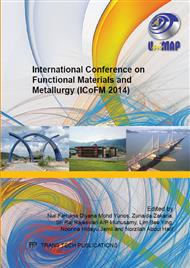[1]
Y.L. Jae and S. Horiuchi, Electroless nickel plating on patterned catalytic surfaces by electron beam lithography, Thin Solid Films 515 (2007) 7798-7804.
DOI: 10.1016/j.tsf.2007.03.188
Google Scholar
[2]
V.K. Bulasara, O. Chandrashekar, R. Uppaluri, Effect of surface roughness and mass transfer enhancement on the performance characteristics of nickel-hypophosphite electroless plating baths for metal-ceramic composite membrane fabrication, Chemical Engineering Research and Design 89 (2011).
DOI: 10.1016/j.cherd.2011.04.007
Google Scholar
[3]
R.C.V. Piatti and J.J. Podesta, Rapid evaluation of electroless nickel plating rate on various catalytic metallic substrates using the coulostatic method with finite pulse width, Surface and Coatings Technology 41 (1990) 333-342.
DOI: 10.1016/0257-8972(90)90144-2
Google Scholar
[4]
J.N. Balaraju, V. Ezhil Selvi, V.K. William Grips, K.S. Rajam, Electrochemical studies on electroless ternary and quartenary Ni-P based alloys, Electrochimica Acta 52 (2006) 1064-1074.
DOI: 10.1016/j.electacta.2006.07.001
Google Scholar
[5]
O.N. Vrublevskaya and T.N. Vorobyova, Electroless Pd-Ni-P alloy plating from ammonium-ethylenediamine solution, Thin Solid Films 524 (2012) 197-204.
DOI: 10.1016/j.tsf.2012.10.020
Google Scholar
[6]
R. Parkinson, Nickel Plating and Electroforming. Essential Industries for Today and the Future.
Google Scholar
[7]
G.O. Mallory and J.B. Hajdu, Electroless Plating: Fundamentals and Applications, reprint ed., Orlando, Florida, (1990).
Google Scholar
[8]
V. Vitry, A. -F. Kanta, F. Delaunois, Initiation and Formation of Electroless Nickel-boron Coatings on Mild Steel: Effect of Substrate Roughness, Materials Science and Engineering B 175 (2010) 266-273.
DOI: 10.1016/j.mseb.2010.08.003
Google Scholar
[9]
S.A. Watson, Electroless Nickel Coatings, Solihull, England, (1989).
Google Scholar
[10]
N. Feldstein and D.J. Lindsay, Composite electroless plating-solutions, processes and articles thereof, U.S. Patent (1992).
Google Scholar
[11]
C.C. Huang, H.C. Hsu, Y.C. Tseng, Structural morphology and magnetism of electroless-plated NiP films on a surface modified Si substrate, Thin Solid Films 520 (2011) 1102-1108.
DOI: 10.1016/j.tsf.2011.09.025
Google Scholar
[12]
S. Armyanov, J. Georgieva, D. Tachev, E. Valova, N. Nyagolova, S. Mehta, D. Leibman, and A. Ruffini, Electroless deposition of Ni-Cu-P alloys in acidic solutions, Electrochemical and Solid-State Letters, 2 (7) (1999) 323-325.
DOI: 10.1149/1.1390824
Google Scholar
[13]
R. Tarozaite, Influence of Cu2+ and dicarboxylic acid additives on electroless nickel plating, (2005).
Google Scholar
[14]
C.H. Hsu, S.C. Chiu, Y.H. Shih, Effects of thickness of electroless Ni-P deposit on corrosion damage of 7075-T6 under salt spray atmosphere, Materials Transactions, Vol45, No. 11 (2004) pp.3201-3208.
DOI: 10.2320/matertrans.45.3201
Google Scholar
[15]
K.M. Latt, Effects of surfactants on characteristics and applications of electroless nickel-phosphorus deposits, National Univeristy of Singapore, (2003).
Google Scholar
[16]
M. Moniruzzaman and S. Roy, Effect of pH on electroless Ni-P coating of conductive and nonconductive materials, International Journal of Automotive and Mechanical Engineering 4 (2011) 481-489.
DOI: 10.15282/ijame.4.2011.9.0039
Google Scholar
[17]
R.M. Abdel Hameed and K.M. EL-Kahtib, Ni-P and Ni-Cu-P modified carbon catalysts for methanol electro-oxidation in KOH solution, International Journal of Hydrogen Energy 35 (2010) 2517-2529.
DOI: 10.1016/j.ijhydene.2009.12.145
Google Scholar
[18]
Y.C. Lin, J.G. Duh, B.S. Chiou, Wettability of electroplated Ni-P in under bump metallurgy with Sn-Ag-Cu Solder, Jurnal of Electronic Materials, Vol 35, No. 1, (2006).
DOI: 10.1007/s11664-006-0177-y
Google Scholar
[19]
S.T. Shiue, C.H. Yang, R.S. Chu, T.J. Yang, Effect of the coating thickness and roughness on the mechanical strength and thermally induced stress voids in nickel-coated optical fibers prepared by electroless plating method, Thin Solid Films 485 (2005).
DOI: 10.1016/j.tsf.2005.04.024
Google Scholar
[20]
T. Watanabe, Nano Plating – Microstructure Formation Theory of Plated Films and a Database of Plated Films, Tokyo, Japan.
DOI: 10.1016/b978-008044375-1/50016-6
Google Scholar


